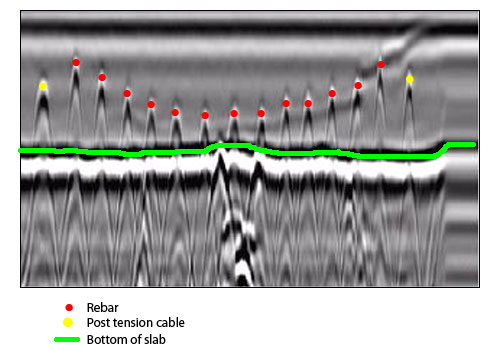Improve Construction Safety And Security with Professional Concrete Scanning
Improve Construction Safety And Security with Professional Concrete Scanning
Blog Article
Past the Surface: Leveraging Advanced Concrete Scanning Techniques for Unmatched Accuracy and Insight
Advanced concrete scanning strategies have emerged as essential devices in this pursuit, offering a look under the surface area to introduce a world of vital understandings. By taking advantage of advanced technologies, professionals can discover abnormalities, examine the problem of concrete frameworks, and make educated choices that form the course of projects.
Importance of Advanced Concrete Scanning
The relevance of using advanced concrete scanning methods exists in the unequaled precision they offer for detecting sub-surface abnormalities and ensuring architectural stability. By utilizing innovative innovations such as ground-penetrating radar (GPR), electromagnetic induction, and advanced finder imaging, building and construction experts can dig underneath the surface area of concrete structures with a degree of accuracy that much surpasses traditional inspection techniques. Concrete Scanning. These techniques make it possible for the identification of surprise hazards like rebar corrosion, voids, channels, or post-tension wires that can endanger the stability and safety and security of a structure with time
Furthermore, progressed concrete scanning gives vital insights into the general condition of a concrete element without the requirement for intrusive actions, decreasing the risk of creating damages during the analysis process. The ability to pinpoint the exact location and depth of potential issues permits targeted repair work and maintenance, inevitably prolonging the life-span of the structure and maximizing its performance. Basically, the importance of sophisticated concrete scanning can not be overstated in the realm of construction and infrastructure upkeep, where precision and dependability are paramount.
Kinds of Cutting-Edge Technologies

Abnormalities and Defect Detection

In enhancement to GPR, concrete scanning methods like thermography and impact-echo testing are additionally efficient in identifying defects and abnormalities. By leveraging these innovative techniques, specialists can proactively address structural problems, making sure the longevity and safety and security of concrete structures.
Assessing Concrete Problem
How can designers precisely review the problem of concrete structures to guarantee their long life and safety? Evaluating the concrete condition is a critical facet of maintaining infrastructure honesty. Various innovative concrete scanning techniques are used for this objective. Ground-penetrating radar (GPR) is typically utilized to evaluate the internal framework of concrete, detecting gaps, splits, and various other abnormalities that may jeopardize its stamina. Additionally, impact-echo testing can offer understandings into the density and honesty of concrete aspects. Ultrasonic pulse velocity screening from this source is one more useful approach for assessing concrete quality by measuring the rate of acoustic waves with the material.
Integrating non-destructive screening techniques with aesthetic inspections permits for a comprehensive analysis of concrete problem, enabling designers to recognize potential concerns early on and implement prompt upkeep or repair services. By explanation leveraging these sophisticated methods, engineers can make certain the long-lasting toughness and safety of concrete frameworks.
Enhancing Decision-Making Processes
In the realm of facilities monitoring, maximizing decision-making processes is crucial for making sure the efficient upkeep and longevity of concrete structures. Boosted decision-making procedures in concrete management include making use of innovative scanning techniques to gather detailed data on the condition of structures. By leveraging technologies such as ground-penetrating radar and 3D imaging, stakeholders can make enlightened decisions concerning substitute, repair, or reinforcement methods.
These advanced scanning strategies offer important insights into the internal composition of concrete, determining potential problems such as spaces, fractures, or rust that may not be noticeable externally. This degree of comprehensive info enables aggressive upkeep planning, decreasing the threat of structural failings and raising the total life expectancy of concrete frameworks.
Furthermore, by integrating digital documentation and evaluation tools right into the decision-making procedure, stakeholders can track the development of concrete conditions gradually, enabling predictive maintenance techniques and optimizing resource appropriation. Ultimately, the combination of sophisticated concrete scanning strategies enhances decision-making processes by giving unequaled precision, insight, and efficiency in facilities administration.
Verdict
In final thought, progressed concrete scanning strategies offer unparalleled accuracy and understanding in spotting abnormalities, problems, and evaluating the condition of concrete structures. By leveraging advanced modern technologies, decision-making processes can be improved, causing more effective and informed remedies for preserving and fixing concrete infrastructure. These strategies play a critical role in making certain the safety and longevity of concrete structures, making them an essential device in the area of building and engineering.
Additionally, progressed concrete scanning gives indispensable understandings right view website into the overall problem of a concrete element without the demand for invasive measures, minimizing the threat of causing damage during the assessment procedure - Concrete Scanning. An additional ingenious technology is 3D X-ray scanning, which gives detailed photos of the interior structure of concrete, providing valuable details without the need for devastating screening. In Addition, Concrete Cover Meters are made use of to measure the thickness of concrete cover over reinforcement bars properly. Improved decision-making processes in concrete management entail utilizing sophisticated scanning techniques to gather in-depth information on the condition of frameworks.In final thought, progressed concrete scanning strategies offer unmatched precision and understanding in spotting abnormalities, flaws, and evaluating the condition of concrete structures
Report this page